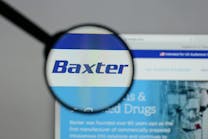Fixing equipment supply chain breakdowns starts with communication
Since the COVID-19 pandemic hit the United States every part of the supply chain has been affected. American resiliency has been truly tested as processes broke down all along the chain. As we reconnected virtually with our customers, we asked them what has kept them up at night. One issue was identified repeatedly: Healthcare supply chains need more visibility and more accurate communication when it comes to equipment logistics.
As temporary field hospitals, labs and triage units popped up all over the country, the demand for equipment to outfit them skyrocketed. Most of these temporary units required a quick turnaround. The state of Rhode Island engaged CME Corp. needing all equipment for three different temporary medical facilities assembled and delivered three weeks later. You can imagine what this type of demand did to the equipment supply chain! When it comes to equipment, there are not significant quantities of excess inventory anywhere along the supply chain, so almost everything had to be built. The manufacturers jumped into action and worked multiple shifts to produce much of the equipment needed. The communication flow between the manufacturer, the distributor and the customer, however, was anything but smooth, accurate and timely. So how do we fix it?
CME uses a sophisticated, proprietary Project Management software program designed for our industry, so we thought we were well prepared. CME’s software can track products in real time from the moment we send the purchase order to a manufacturer to when we deliver it direct to site. Yet, we were having some of the same problems as everyone else. We started looking into every part of the process that the software did not control and found some interesting gaps.
Manufacturer communications
When we studied the communication flow with manufacturers, we found a few troublesome holes. Most equipment manufacturers send an order confirmation containing an estimated ship date. This ship date is computer generated and is based on internal workflow and inventory availability data. When the pandemic hit, manufacturer workflows were over-taxed and incorrect ship dates abounded. When items were delayed or backordered, we found that some manufacturers contacted our sales representatives, some contacted our internal order process team and others did not contact us at all!
Internal distributor communications
We realized that some of the communication coming from our manufacturers was going to wrong email addresses. Most times the information ended up in the right place, but it meant extra time was spent forwarding the emails. Unfortunately, there were times the information never got to the correct person and, therefore, crucial data was not entered into our software.
Customer communications
Every customer had different considerations and needs. Some customers had us communicate with several people in the supply chain, and that usually worked the best. We had one point of contact in some circumstances with varying degrees of success. We also received inconsistent direction from different contacts within the same healthcare system, which had to be sorted out, and this created further delays.
Possible solutions
One adage proven to be true is that any garbage we input into our software program created garbage out! Whether a healthcare entity works with a medical equipment distributor or not, getting the most accurate and timely information is paramount to having a successful equipment transaction. Most importantly, we need to ensure that the confirmation, backorder, and shipping information we get from our manufacturers are factual and up to date. Everyone in the supply chain needs to focus internally to shore up his or her own communication. If a manufacturer sends something to the wrong department, we must go to the source, follow up and make sure that next time the information goes to the correct department first. Further, we need to make sure, at the inception of the equipment purchase, to get all of the customer contacts with whom we will need to communicate to ensure a smooth transaction and delivery. When an equipment purchase is time-sensitive, making the supply chain as efficient and agile as possible is the key to success!
For access to relevant case studies on this topic, visit www.cmecorp.com
CME Corp is a distributor that focuses on equipment only. Our mission at CME is to help healthcare facilities nationwide reduce the total cost of the equipment they purchase and make their equipment specification, installation, maintenance, and disposition processes more efficient. CME carries more than two million items from more than 2,000 manufacturers and offers customized services that include direct-to-site delivery, biomedical services and disposition services.
Cindy Juhas | Chief Strategy Officer
Cindy Juhas is Chief Strategy Officer for CME Corp (CME), a national full-service healthcare equipment distributor, whose mission is to help customers reduce the cost of the new equipment they purchase, and make their equipment specification, delivery, installation, maintenance and disposal processes more efficient. CME offers a full array of logistical, biomedical and technical services to serve their healthcare partners. She can be reached at [email protected].





